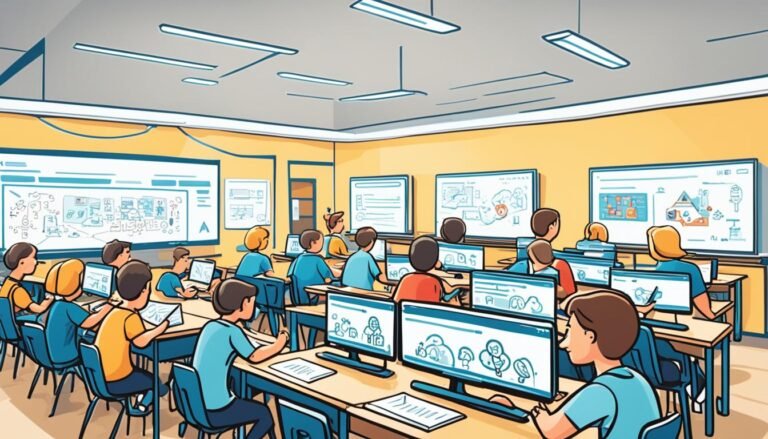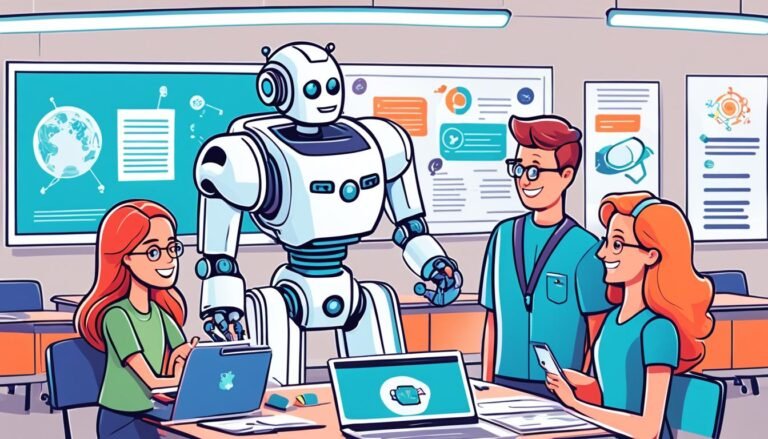AI in Educational Policy and Ethics: Shaping the Future
In a bustling classroom at Excel High School, a math teacher watched in awe. Her students were learning from an AI-based tutor. Learning that might have taken hours now went smoothly with a tool that interacted with the students. The promise of AI in education is amazing, but it also raises ethical and policy questions. We are already in this future, and it’s coming faster than we thought.
The University of Maryland has seen AI’s big impact, becoming a top 15 school for AI. The setting up of the AIM was a key step. It pulls experts from all over, showing a clear goal: to make AI education open to all while being careful in its use.
President Joe Biden and Maryland Governor Wes Moore say using AI in education needs to be done right. The University of Maryland’s new leaders, like Hal Daumé III as AIM’s first director, support this idea. They’re joined by Neda Atanasoski and Sheena Erete. They will lead in education and research, underlining the effort to use AI wisely.
A recent report from the Department of Education highlights AI’s importance in education. It talks about better learning, personal education, and helping teachers plan lessons and test students. But, we need to make sure AI is used in a fair, safe, and ethical way. It’s key to ensure AI helps students, teachers, and parents positively.
Key Takeaways
- The University of Maryland is proactively shaping the future of AI in education through its AIM initiative.
- President Biden and Governor Moore emphasize the responsible use of AI in educational settings.
- AI technology offers adaptive and personalized learning experiences.
- Ethical and equitable policies are crucial for fair AI integration in education.
- Collaboration between policymakers, educators, and technologists is essential for responsible AI development.
Introduction to AI in Education
The evolution of AI in educational settings has changed learning and teaching over 10 years. Technologies like machine learning (ML), generative AI (GAI), and deep learning (DL) are everywhere in schools. They help students, teachers, and schools create better and more fun ways to learn. As AI grows, it’s key to know how it started and got to today. We also need to see how AI will keep changing education in the future.
The Evolution of AI in Educational Settings
The evolution of AI in educational settings has seen big tech steps. We went from simple rules to now using complex tools like GANs and GPTs. For example, OpenAI’s GPT-3 can write almost like people, making virtual tutors and smart research helpers. This has really changed the way we look at tech in education.
AI technology in education aims to fix learning gaps. It does this by making lessons fit each student’s unique needs. But, not all students or schools have the same tech access. Using AI in lessons can also bring up worries about keeping data safe and being fair. So, we must use AI in ways that are very careful and fair to everyone.
Current Trends and Technologies
Looking at current trends in educational AI, we see big changes in how we teach and learn. New tools like ChatGPT and GPT-4 make learning more hands-on and adapting. They can talk to students and even help with exams, making lessons more fun and focused.
Now, we’re working hard to make sure AI is used in the right way. There are rules and plans to make sure it’s fair and safe. Making AI that’s good and right involves checking often, using lots of different info, and making things that treat everyone fairly. The main goal is to teach students skills that are super important for the future like understanding AI and being creative.
The University at Buffalo and Buffalo Public Schools are hosting classes on AI in Education from Jan. 23, 2024, to Dec. 17, 2024. These will talk about “Introduction to AI and Its Use in Educational Settings,” “Leveraging Machine Learning for Personalized Education/Special Needs,” and “The Ethical Side of AI in Education.”
| Date | Time | Facilitators | Specific Topics |
|---|---|---|---|
| Jan. 23, 2024 – Dec. 17, 2024 | 4 to 5 p.m. | University at Buffalo, Buffalo Public Schools Experts |
|
Benefits of AI in Classroom Instruction
AI is changing the way we learn by making lessons personal and making tests fairer and quicker to grade.
Personalized Learning Experiences
AI is big for giving students the exact lesson they need. This means that every student can learn at their pace, getting help as soon as they need it. It makes sure no one is left behind. With AI, teaching is all about what each student needs to really understand and enjoy learning, as found by Gašević et al. (2023).
Automated Grading and Feedback
AI is also great for grading. It can mark assignments super quickly, giving detailed feedback. This makes grading fair and saves teachers a lot of time. But it’s important to have humans checking to make sure the AI is right and fair, as the experts warn.
| Benefits | Description |
|---|---|
| Personalized Learning | Real-time adjustments and tailored support for individual student needs. |
| Automated Grading | Efficient and unbiased assessment of student work, including essays and standardized tests. |
| Immediate Feedback | Quick and detailed feedback on assignments, highlighting strengths and areas for improvement. |
Ethical Implications of AI in Education
AI is becoming very important in schools. It is important to look at its ethical issues. This includes making sure AI is fair and does not harm anyone. We also need to keep student data safe.
Bias and Fairness in AI Algorithms
AI can sometimes be unfair, which is a big problem. It might not treat all students the same. This can make it hard for some kids to use AI in learning. “Algorithmic bias: Should students pay the price?” talks about why this is wrong. It says AI must be made carefully to make sure everyone gets the same chances.
Not all AI systems work the same for every student. For example, ChatGPT might not always be right. It can sometimes give wrong answers. This shows we need to test AI a lot to be sure it’s fair. If we don’t, it could make schooling harder for some kids.
Data Privacy and Security Concerns
Student data must be kept safe when using AI. A study found that some learning programs collect a lot of data. But sometimes, they don’t keep it safe.
Keeping data safe is very important in schools. The ENAI says we must use AI in a way that everyone can see is honest. It tells schools to be open about how they use AI.
AI could also make it easier to copy work or forget how to do research. This is a big problem. Teachers and leaders need to make sure AI helps students without causing these problems. They have to choose AI that is very fair and learns from true information.
| Study Findings | Implications |
|---|---|
| Accuracy varied from 4.8% to 26% | Highlights need for rigorous evaluation of AI models |
| Confusion with competitive training data | Potential agreement with falsehoods |
| Erosion of research skills due to AI reliance | Needs for balancing automation with critical skill development |
| AI-Generated Content indistinguishable from human-created work | Raises concerns about plagiarism and authenticity |
| Potential breaches of sensitive student information | Necessitates strong data governance policies |
AI in Educational Policy and Ethics
Making sure AI is used ethically in schools needs strong rules. These rules must handle the tricks of using AI well and fairly. They need to watch over privacy, equality, and right and wrong in its use. Researchers and others are key. They help figure out what AI might do and suggest rules to keep things fair and moving forward.
Policy Frameworks Governing AI in Schools
Creating good rules for AI in school is very important. These rules help make sure AI tools in schools are used the right way. For example, the Rome Call for AI Ethics and the Data Ethics Decision Aid are great starts in using AI wisely. Australia’s framework by Dawson et al. (2019) focuses on key ethical ideas for using AI in schools. It stresses the need for rules that look after privacy, treat everyone fairly, and keep things clear.
The Role of Researchers and Stakeholders
Experts and those involved have a big part in making AI rules in schools. Research by Amiel & Reeves (2008) and Fishman et al. (2013) shows ways to design and use educational tech better. They point out that we need rules at every school level, from big districts to daily lessons. The AI CIRCLS Expertise Exchange shows how working together can create good AI and school rules.
Good rules for using AI in schools need ideas from many, like teachers, tech experts, and students. The AI CIRCLS Expertise Exchange brought together 49 people in several meetings. This shows how important working together is. Using AI carefully can make learning better, while keeping ethics in check.
Challenges in Implementing AI in Education
Using AI in education has many tough challenges. One big problem is not having clear rules for using AI in a good way. A study with 102 high school and college leaders found most schools don’t have these important rules.
High schools might not try hard to make rules for AI like colleges do. And if they do have rules, they might forget about important things like keeping students’ info safe. This can make using AI at school hard.
Leaders in schools say we need rules to keep students safe from problems like cheating with AI. They did a mix of surveys and research with over 100 school leaders in the U.S. This showed how hard it is to make and follow AI rules right now.
There are no detailed special rules just for AI tools like ChatGPT. Schools also need good tech setups to use AI well, which can be hard to get. But it’s not only about technology. The rules for AI should be fair, clear, and protect privacy and honesty.
Earlier studies say it’s very important to look at AI from many angles. They suggest making rules that can change and grow over time. This would help schools use AI responsibly.
Below is a table with the main challenges in using AI:
| Challenges | Details |
|---|---|
| Lack of Specialized Guidelines | Most schools don’t have clear rules for using AI the right way. |
| Uneven Policy Development | High schools don’t make rules for AI as much as colleges do. |
| Privacy and Transparency | The rules often forget about important things like keeping students’ info safe. |
| Technological Infrastructure | Schools need good systems to use AI, which can be hard to get. |
| Ethical Considerations | The rules should be fair, clear, and protect privacy and honesty. |
In the end, solving the problems with AI needs many different efforts. We have to think about the tech, how we teach, and what is right to do. This will help AI be a good part of education.
Case Studies: AI in Action within Educational Institutions
AI is changing education through bright examples in K-12 and colleges. These stories show AI’s power and wide use.
Success Stories from K-12 Schools
Minerva High School shows a big AI win. In 2012, it had a nine percent dropout rate and only 55 percent graduated on time. This was lower than the 76.4 percent state average. Hephaestats, a smart tool, found eight signs a student might drop out, predicting right 92 percent of the time. It looked at student details, grades, and teacher info to spot issues and offer help.
After using Hephaestats, Minerva High School got better by the 2016-17 year. The grad rate jumped to 85 percent, and dropout fell to five percent. They did this by making personal class schedules, changing lunch, and helping students who needed extra support.
| Year | Dropout Rate | Graduation Rate |
|---|---|---|
| 2012 | 9% | 55% |
| 2016-17 | 5% | 85% |
Yet, some worried about privacy with Hephaestats using data without clear permission. Even so, these improvements show AI can be great in K-12 schools.
Higher Education Implementations
AI is also shining in colleges, making research and learning better with its tools. It’s helping with data work, studies, and smart tutoring, leading to big steps forward.
In Hong Kong, almost one in three students and 180 teachers used AI for studying. Six out of ten students used AI chatbots a lot for homework. Still, many students think cheating with AI is wrong. And some think their teachers don’t know, even if the school bans AI for work.
In the UK, eight universities say using AI for work is cheating. Also, in Australia, some schools again use handwritten tests because they worry about AI tools that help write responses.
These stories show how AI is changing schools and colleges. They remind us to talk about ethics, make fair policies, and keep watching how AI is used in education.
Future Trends of AI in Education
The future of AI in education looks bright. It’s set to change how we teach and learn. New AI trends like GPT-4 will help create content and translate languages better than ever before.
Advancements in AI Technologies
AI is making learning more personal. Intelligent tutoring and adaptive learning systems focus on each student’s needs. They also use data to predict how well a student might do. This helps spot students who might need extra help early. Plus, AI can grade work, making life easier for teachers.
Potential Impact on Educational Practices
AI’s effect on teaching is big. It will make learning easier to get, less costly, and quicker.
It helps students by suggesting what to do next and providing smart tutoring. But, using AI must be fair, private, and safe for everyone. There are worries about cheating and using AI too much.
| Key Trend | Impact | Challenges |
|---|---|---|
| Learning Analytics | Improves accessibility for students (68%) | Resource and knowledge inadequacies |
| Adaptive Learning | Individualized learning experiences | Organizational deficits |
| Predictive Analytics | Identifies at-risk students | Privacy and ethical concerns |
The Delphi study found that privacy, trustworthy AI, and fairness are key. So, we must keep checking that AI in education is used right. This way, it will continue to help us reach educational goals.
Ethical AI Development in the Education Sector
The journey of ethical AI in education focuses on good practices and clear rules. AI brings big benefits but also raises big ethical issues. It’s critical to deal with problems like bias and privacy so AI helps us learn better.
Dr. Mario Herane knows a lot about leading in education and tech. He thinks it’s very important to govern AI in educational settings fairly. His deep knowledge and degrees show we must use AI carefully.
AI moves quickly, making ethical rules hard to keep up with. So, schools should ensure data protection standards and honesty to keep AI trustworthy. This approach is key to handle privacy worries, just like concerns around drone use.
The table below points out key ethical areas for AI in education:
| Focus Area | Importance | Example/Statistical Data |
|---|---|---|
| Data Privacy | Ensures student information is secure and used transparently | Data show more security breaches in schools using AI systems each year. |
| Bias and Discrimination | Maintains fairness in AI algorithms | Not many people attended the “Ethics of AIED. Who Cares?” meetings in 2018-2019. |
| Transparency in AI Decisions | Builds trust among students, parents, and educators | People are not sure how AI makes choices, according to studies. |
| Digital Divide | Addresses technological discrepancies among students | There’s a tech gap between city and country schools when it comes to AI. |
Working together is key to using AI responsibly. Groups like the EU and UNESCO stress clear rules, privacy, and fairness. They support using AI in ways that care about people and their freedom.
Keeping AI use ethical in schools requires a steady effort. By putting ethics first, schools can enjoy the good of AI while avoiding its bad. This leads to a school world where AI is used fairly and justly.
Strategies for Integrating AI into Curriculum
AI is becoming very important in schools. It’s key to have good plans for AI in lessons. These plans must cover everything and be ready for the future job market where AI is big.
Best Practices for Teachers
Teachers are essential for making AI work well in classes. They should follow these top tips:
- Ongoing Professional Development: Learning never stops. Teachers should keep learning about AI to get better at it.
- Incorporation of AI Tools: Use AI tools to teach better. For example, ChatGPT can help students one-on-one, or Midjourney for fun projects.
- Fostering AI Literacy: Teach students about AI basics and its impacts. This helps them understand AI better and be ready for what’s coming.
Resources and Tools for Administrators
School leaders help make sure AI is used well and fairly. Good AI tools in schools can make things easier, improve choices, and keep school quality high.
- Administrative AI Tools: Use AI for student info, to follow how they’re doing, and for some school tasks. It makes managing things smoother.
- Guidance and Support: Turn to places like TeachAI for help. They can help with making AI policies and fitting them into the school.
- Ethical Governance: Be careful with AI rules, focusing on student info safety, cyberbullying, and teaching kids about digital life.
Soon, AI will change 40% of jobs. So, schools need to welcome AI. Everyone working in education must join hands. This is to make sure AI in schools is done right and helps students for the long haul.
Conclusion
Looking at AI’s key part in the future of teaching, we see it brings big benefits and challenges. For example, in Brazil, Khan Academy helps 4 million students do better in math. AI makes learning personal, improves grading, and helps teachers teach better.
Yet, using AI in education must be careful. We need to watch out for bias, keep data safe, and make sure it’s used fairly. Making sure AI is open and fair is very important. Still, many colleges want to use more data for good and do it in the right way, even if it’s hard.
To make AI in education work, we all need to help. This means teachers, leaders, and tech people working together. They should write rules to make sure AI helps all students fairly. Keeping AI honest and dependable will make teaching better and fair for everyone, creating a better education world.
Source Links
- Shaping the Future of AI | Office of the Provost
- AI’s Role in the Future of Education
- Shaping the future of AI in healthcare through ethics and governance – Humanities and Social Sciences Communications
- Research Guides: Artificial Intelligence (AI) in Education: AI and ethics
- AI + Education Learning Community Series
- Ensuring Equity: The Role of AI in Education Ethics
- Ethical AI for Teaching and Learning
- Incorporating Artificial Intelligence Into The Classroom: An Examination Of Benefits, Challenges, And Best Practices
- 5 Pros and Cons of AI in the Education Sector
- Artificial intelligence in education: Addressing ethical challenges in K-12 settings
- Artificial Intelligence: Ethical Considerations In Academia
- ENAI Recommendations on the ethical use of Artificial Intelligence in Education – International Journal for Educational Integrity
- Education for AI, not AI for Education: The Role of Education and Ethics in National AI Policy Strategies – International Journal of Artificial Intelligence in Education
- Crafting ethical AI landscapes in K-12 education
- AI and Education Policy
- A Study of AI Policies in Education
- Integrating AI into Education: Possibilities and Challenges
- Ethical principles for artificial intelligence in education – Education and Information Technologies
- A comprehensive AI policy education framework for university teaching and learning – International Journal of Educational Technology in Higher Education
- 43 Examples of Artificial Intelligence in Education
- The Future of Education: How Artificial Intelligence is Transforming Learning
- Artificial Intelligence in Education: Implications for Policymakers, Researchers, and Practitioners – Technology, Knowledge and Learning
- The Future of AI in Higher Education
- AI in Education, Balancing Innovation with Ethics – Higher Education Digest
- Ethics of AI in Education: Towards a Community-Wide Framework – International Journal of Artificial Intelligence in Education
- Research Guides: Artificial Intelligence (AI) in Education: AI and ethics
- 5 key policy ideas to integrate AI in education effectively
- Strategies for Integrating Generative AI into Higher Education: Navigating Challenges and Leveraging Opportunities
- Human-Centered AI Guidance for K-12 Edition 2
- Ethical Considerations for AI in Higher Education: Ensuring Fairness and Transparency | Liaison
- The ethics of AI in education: Balancing innovation and privacy concerns







